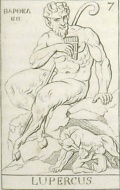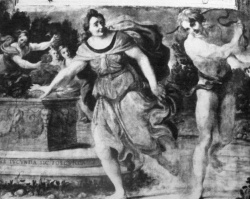Lupercalia

The Lupercalia was an ancient purity and fertility festival celebrated by the Romans. It possibly dates back to pre-Roman times and may also have connections to ancient Greek festivals.
"Lupercalia" translates out into "Wolf Festival." Other important Roman festivals were the Bacchanalia and the Saturnalia.
Background
The Lupercalia was the festival of Lupercus, the god of shepherds, who is sometimes identified with Faunus (the Roman equivalent of the Greek god Pan). The festival was celebrated on February 15 near the holy cave of Lupercal on the Palatine.
According to other sources, the Lupercalia tradition was believed to have been established by the mythological Romulus, who was suckled by a she-wolf (Lupa) together with his brother Remus, the two orphans who (according to the legend) founded Rome. In this interpretation, the Lupercalia was a festival of Lupa, rather than of Lupercus.
Celebrations and rites

The festival began with the sacrifice of two male goats and a dog by the Luperci (priests of Faunus, dressed only in a goatskin) or by the flamen dialis (high priests of Jupiter). Then two patrician young Luperci were led to the altar, to be anointed on their foreheads with the sacrificial blood, which was wiped off the bloody knife with wool soaked in milk, after which they were expected to smile and laugh. The smearing of the forehead with blood is sometimes believed to refer to human sacrifice originally practised at the festival.
The sacrificial feast followed, after which the Luperci cut thongs from the skins of the victims, which were called Februa, dressed themselves in the skins of the sacrificed goats, in imitation of Lupercus, and ran round the walls of the old Palatine city, the line of which was marked with stones, with the thongs in their hands in two bands, striking the people who crowded near. Girls and young women would line up on their route to receive lashes from these whips. This was believed to ensure fertility, prevent sterility in women and ease the pains of childbirth.
The Lupercalia (together with the Saturnalia and other pre-Christian and pagan rites) is believed to have influenced post-Roman spring festivals such as Carnival, Easter, and Valentine's Day. The Lupercalia whippings seem to be reflected in regional Carnival and Easter Monday whipping rituals that persist in some places to the present day.
See also
- Satyr
- Sparta
- Christmas and spanking
- Lupercal (an Anglo-Australian spanking author)
- More information is available at [ Wikipedia:Lupercalia ]
Chat rooms • What links here • Copyright info • Contact information • Category:Root